Lemme Outta da Box!
Since time immemorial—or at least as long as I can remember in the vast dark of my dreaming—man has sought for moments in life to leave an individuated ego-skin in order to reconnect with a fundamental mystery, to directly experience the ‘world beyond’, the ‘realm of forms’, ‘a separate reality’ or the ‘harmony of the spheres’; not—I would suppose—out of boredom, listless ennui or the desire for ‘entertainment’, but paradoxically through a quite stubborn inclination toward survival in the physical world. To find a means of subsistence, to heal one’s self or family, man has had occasion to resort to ekstasis1 (“to be or stand outside oneself”) or, we could say, to ‘step outside of the box’. Thus the wisdom of an oft cited sentiment: ‘You can’t solve problems by using the same kind of thinking you used when you got into them.’2
In ‘The Cosmic Serpent’, Jeremy Narby relates his experiences with a native Peruvian community when in the 1980’s he was working towards preserving their Amazonian forests. When he asked them how they came to cultivate such knowledge of an outstanding pharmacopeia, the people routinely replied that knowledge of a plant’s medicinal properties was told them directly by the plants themselves—in visions they communicate with the essences of different lifeforms, including the plants, and in this way they obtain the information regarding the plant’s particular character and uses: “Nature speaks to people in visions and dreams.”3
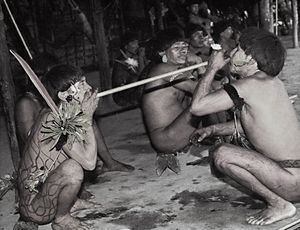 |
| Yanomami of the Amazon Basin |
Apart from an acute need of plant medicines for some particular physical ailment, man does well on occasion to take advantage of the possibilities at hand to ‘heal the soul’ by seeing things from another perspective or stepping outside of the box as it were. While maintaining too myopic an obsession with the quotidian corporeal context, one can become blind to wonders and opportunities actually available in a living world.
Various religions have inherited—or have at least had to reconcile—man’s need to ‘go beyond’. As someone who was brought up in a religion that practices baptism by immersion4, I find it interesting to consider how this ‘technique’ of immersion could have been used in very ancient times as a practical—if hazardous—means of inducing altered states of awareness, bringing about something like what is now termed the “Near-Death Experience.” By many accounts it would seem a fruitful procedure, this ‘being reborn’, and for the intrepid seeker who would willfully submit to these practices—dangers be damned—we can see how an attitude of reverence would be prescriptive; and how a certain faith in one’s chosen practitioner could be a helpful aid if one lacked the benefit of that age old agent-of-change ‘nothing left to lose’.
***
In what may be at least a mildly amusing diversion I’ll relate here two anecdotes—what I would qualify as my own Near Death Experiences—neither of which occurred when at age eight I was initiated into the previously mentioned and wholly innocuous coming of age ceremony practiced by The Church of Jesus Christ of Latter-day Saints.
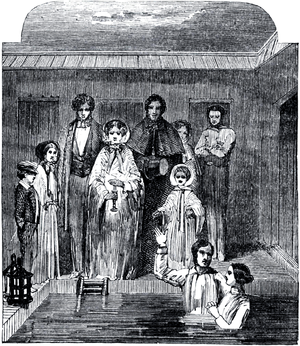 |
| Mormon baptism circa 1850s |
The first of these came to pass when I was five years old: I’m told that I jumped out from behind a bush to surprise my older brother as he was joy riding his motorbike on the path through our spacious backyard. The impact involved a meeting of some part of the motorcycle with my forehead—just below the hairline, slightly left of center—and sent me flying some five yards through the air. Though I can’t recall what exactly I may have had in mind, I strongly doubt that it had anything to do with suicide or the attainment of a mystical experience. What I do remember is flying in the air over the entire two acres of our family plot and watching my mother from an autoscopic5 perspective as she washed my forehead clean of blood under the bathtub faucet.
The second event I had undergone as a disaffected youth, age 17, living in the first of a series of extra-familial bohemian households. Having free access to a shady fringe-underground, being relatively heedless and tending to experiment, I had the misfortune at some point to have been passed some ‘bad acid’6 which my slight physiognomy had a difficult time assimilating. After my grasp on time and physical sensations had ‘dripped’ off of me (as though by a steadily mounting melting process) my body apparently acquired some super-human strength, operated in puppet fashion through ‘strings’ from a world of half-conceivable dreamlike scenes. Physical time had entirely fractured and was perceived kaleidoscopically, each moment in its own eternity. I was occupied in a timeless world of archetypes in which a prominent theme was one of ‘breaking out’. Back in the ‘real world’ several windows had indeed also been ‘broken though’—the penetrating object being in this case my head—and so there was a bit of a bloody mess on the floor as well. Apparently It took five people to hold down what I would certainly classify as a rather scrawny body. An ambulance was called: A police car arrived. They carried me away in the back seat. The left rear car door window did not escape intact.
At last I ‘came to’ in hospital. Sometime during the phase of physical re-entry toward the end of the perplexing and mmm… disconcerting itinerary I found myself ‘around’ my body in the care room bed while the sheet was raised over my face in a death scene cliché—there was nothing more they could do.
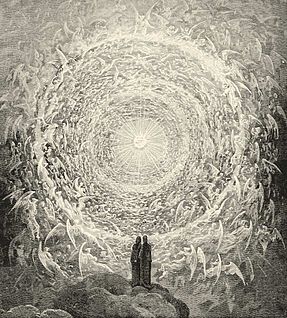 |
| Gustave Doré’s depiction of Dante’s “Paradiso” |
I’ve read somewhere about the phenomenon of ‘the adulation of nurses by the wounded’ and it seems to bear some resemblance to my case here: upon a final ‘awakening’ to linear reality I saw her face—and it was as though having spent days watching a cherished film star in her most renown role, of a sudden, I was confronted by her there above me, still in character though radiant in actual life. Astonished, I had a difficult time believing that the terrific nightmare I’d come out of had some relation to the daytime reality with which I had now to live. I sensed first that familiar relief upon awakening from a horrible nightmare only to be robbed at once of a large portion of this relief—finding myself on the wrong side of a layered dream.
Though I’m not sure that I would concur with the popular adage ‘What doesn’t kill you makes you stronger’—and I don’t know to what extent these events may have changed the grand scheme of my life—one thing is evident: I was lucky. In one instance lucky to have survived the skull fracture without some kind of permanent brain damage (or do you question my normalcy?!) and the other for getting off with neither permanent injury nor permanent record.7
Needless to say, neither of these experiences are to be recommended, and fortunate we are indeed with such a wide range of alternatives—provided by a wise and gentle world—to perceive portions of this ‘great beyond’ in rather more amenable fashions.
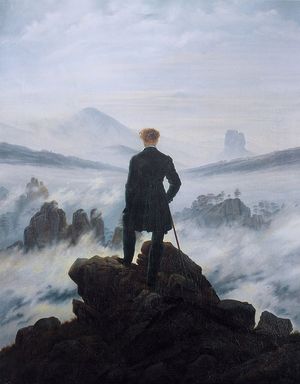 |
| 'Der Wanderer über dem Nebelmeer' |
***
When we hike up to a high point on a mountain range and look over the expanse, what is it that we feel or sense? Another perspective different from the common ‘low-level’ awareness—as though before we were somehow ‘ants in a maze’—now purveying the contours of a strange new land, a land we’ve always inhabited unawares and so we too are ever a part of this world-we-perceive-from-on-high; the opportunities for exploration there, the hidden byways, the changes of scenery in moving from here to there.
Music also occupies the province of all authentic art as a means to connect to a world beyond oneself, to envelop in an ‘other’ sphere, to touch a place of pure ideas with which we resonate and that put the moments of our life in a larger perspective. Schopenhauer—that modern philosopher much obsessed with music—contended that it in particular, above the other arts, has the ability to communicate its meaning directly through a non-dualist, aesthetic experience in which one perceives “the objective essence of things”.8 The Symbolist Art movement of the 19th Century sought to explore “perceptible surfaces created to represent their esoteric affinities with the primordial Ideals"9; In other words, ‘psychedelic’—as in psychoactive or mind expanding—access points to something spiritual, something beyond the mundane.
I’ll state for myself unabashed (and there are others I know!) that the process of creating music is a ‘spiritual practice’—an occupation so compelling that it can often eclipse all other earthly concerns. But what is the effect of this art on others? Can this ekstasis be shared or at least communicated? Communication being no small part in the purpose of pursuing this art, even the prim possibility that somewhere, someone ‘gets it’ (and can use the technique as a key to open an imaginal realm glimpsed also by the artist) is enough to goad the artist on, in spite of large difficulties, to the completion of a ‘Great Work’—a work that can be presented in our collective material sphere.
It is inscrutably humbling when comes a letter return addressed anywhere-in-the-world, from someone I couldn’t possibly otherwise have come in contact with, which relates a personal experience of ‘soul-travel’, actual mind expansion, or ekstasis of some kind—facilitated through or accompanied by the music; some simply thankful for ‘a safe place to land’, some pushed to their own metaphysical mountain range, or on rare occasion someone raising the courage to tell me that the music literally ‘saved their life’ during a particularly difficult passage. In these instances I cannot help but step back and pull a large breath, staggered by a temporary blow of awe. It reinforces paradoxically the knowledge that I myself am ever a servant to this ‘energy’ in linguistic and vibrational form that come through the Music.
***
After making a dozen odd albums of this music and having spent a large quantity of days traveling to over 30 countries world-wide10 in sharing this, I have yet a fair allotment of work ahead—some presently outlined, some only obscurely apprehended—and I’ll continue this process of channeling music as long as the ecstatic imperative prevails; as it has these years: at times aggressive in its urgency; at times patient, waiting for me as I deal with certain of life’s predicaments, waiting for me as I ‘get my act together’, waiting for me to ‘grow up’ and accept some aspects of reality or personal responsibility.
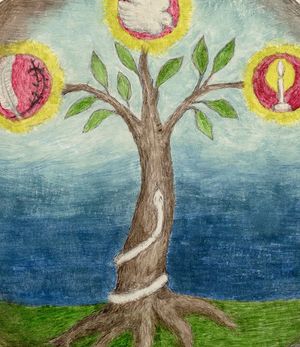 |
| The Serpent and the Dove, |
The last way-post for this ‘Symbolist Folk Music’ with which I’ve been involved these years is the recent In Gowan Ring album The Serpent and the Dove, which for your convenience I’ve linked here:
"Our normal waking consciousness, rational consciousness as we call it, is but one special type of consciousness, whilst all about it, parted from it by the filmiest of screens, there lie potential forms of consciousness entirely different. We may go through life without suspecting their existence; but apply the requisite stimulus, and at a touch they are there in all their completeness... No account of the universe in its totality can be final which leaves these other forms of consciousness quite disregarded. How to regard them is the question...At any rate, they forbid our premature closing of accounts with reality."
–William James, Varieties of Religious Experience
1 From the Ancient Greek ἔκστασις, “to be or stand outside oneself, a removal to elsewhere”
2 Albert Einstein, et al.
3 Paraphrased from various youtube interviews with Jeremy Narby
4 In contradistinction to baptism by affusion (pouring) or baptism by aspersion (sprinkling)
5 Autoscopy is the experience in which an individual perceives the surrounding environment from a different perspective, from a position outside of his or her own body. Autoscopy comes from the ancient Greek αὐτός ("self") and σκοπός ("watcher").
6 I believe this may have been Phencyclidine (‘PCP’), a very dangerous synthetic drug created after World War II as a surgical anesthetic. The effects of Phencyclidine vary radically between individuals.
7 "Being 'underage' I was let off easy: a few days in juvenile hall, minor scrapes and a $90 fine to replace the fuzz’s window. Had all this occurred a few months later it could have had rather more lasting repercussions.
8 The effect of music is so very much more powerful and penetrating than is that of the other arts, for these others speak only of the shadow, but music of the essence." -Vol. I, Ch. II, The World As Will and Idea "The composer reveals the innermost nature of the world, and expresses the profoundest wisdom in a language that his reasoning faculty does not understand, just as a magnetic somnambulist gives information about things of which she has no conception when she is awake. Therefore in the composer, more than in any other artist, the man is entirely separate and distinct from the artist." -Vol. I, Ch. III, The World As Will and Idea
9 "Ainsi, dans cet art, les tableaux de la nature, les actions des humains, tous les phénomènes concrets ne sauraient se manifester eux-mêmes ; ce sont là des apparences sensibles destinées à représenter leurs affinités ésotériques avec des Idées primordiales." (In this art, scenes from nature, human activities, and all other real world phenomena will not be described for their own sake; here, they are perceptible surfaces created to represent their esoteric affinities with the primordial Ideals.) -Jean Moreas, Le Manifeste du Symbolisme, 1886
10 Yes, I counted once!

